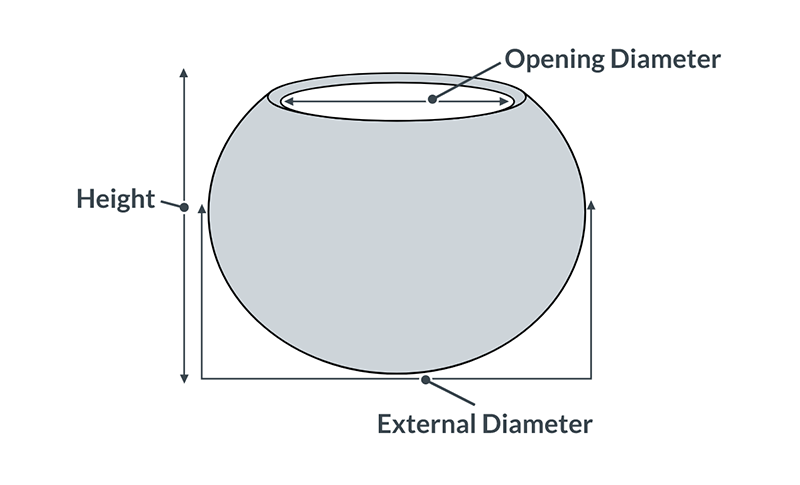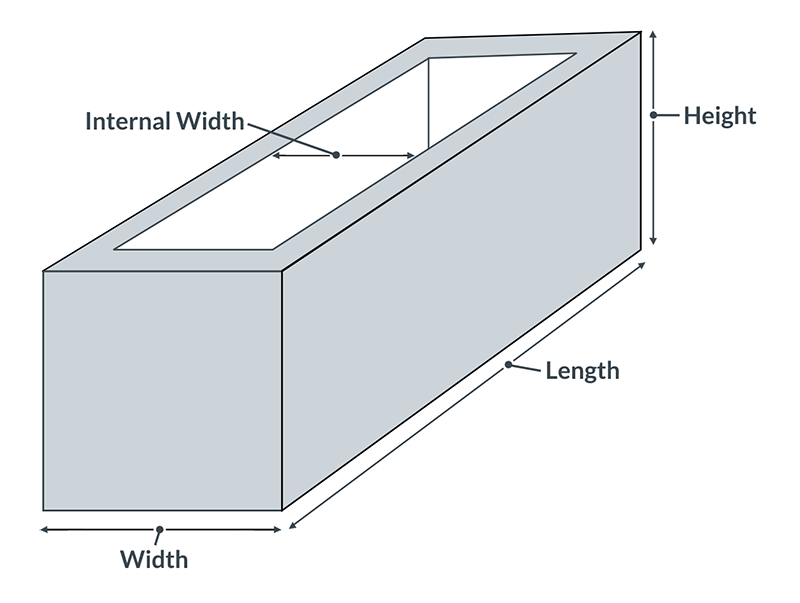Plant sizes are shown as the grow pot diameter x the total height of the plant. This means the diameter of the grow pot at the top of rim x the total height of the plant including the grow pot. It therefore includes the plant roots etc as well as the height or length of the plant.
Please note: plant heights are approximate and are provided for indicative purposes only. Plants suitable for hanging may be depicted in a hanging grow pot, the actual grow pot used to ship the plant might not include these attachments.
For plants in soil the key size in determining the maturity and fullness of a plant is the diameter of the grow pot. The larger the diameter, the more mature the plant.
Hydroculture plants are measured the same way as soil plants, however the grow pots are sized by diameter plus their standardised heights, which allows a water meter to be fitted. For example: an 18/19 grow pot has an 18cm diameter at the rim and is 19cm tall.
Hydroculture plant roots have been specially adapted to grow in hydrogranules, which creates a smaller, more fleshy and hardier root system. This results in mature plants being available in smaller grow pots than their soil based equivalents.
Check the grow pot diameter:
Determine the plant's grow pot diameter. Compare this to the size of the opening of your chosen decorative pot and ensure it is big enough to insert the plant's grow pot through the opening (see diagram below).
We show the size of the decorative pot openings for each pot as you click the different size options or hover over the size buttons.
Tip: Pick a decorative pot that has an opening about 1cm larger than the size of the plant's grow pot. For smaller plants (up to 14cm grow pots) you should go slightly smaller and for larger plants (above 24cm) you can add 2-3cm without the pot looking too large for the plant.
Note: If the shape of the planter tapers strongly at the base, it might not be wide enough for your plant to sit squarely at the bottom. In this case you can add a liner on a small layer of pebbles to increase the size of the base. This will however raise the height of the plant slightly in the planter.
For hydroculture plants use the size tip to select a decorative pot that will accommodate the waterproof liner recommended for the plant in the hydro kit.
Artstone planters include a non-removable water reservoir, which raises the internal base height of the planter. These planters work best with the plant re-potted directly into them rather than left in their grow pots. If the intention is to leave the plant in its grow pot and sit it directly into the Artstone planter rather than re-potting the plant directly into the planter, please ensure you select a large enough size that will have enough internal height to hide the grow pot.
Check the grow pot height:
Soil plants - The height of the grow pot can vary slightly, but is usually slightly smaller or the same as its diameter. Check your planter will be tall enough to hide the grow pot if you are not re-potting directly into the planter.
Hydroculture plants - These require a hydro kit for assembly, this includes a waterproof pot liner with a base wide enough to accommodate the hydroculture grow pot. The size tip provided for each hydroculture plant provides a recommended size for the external diameter of the decorative pots that will accommodate the specified waterproof liner.
The grow pot height is standardised (normally 12cm or 19cm) and shown on the size option for each hydroculture plant. Ensure the external height of your decorative pot is at least 2-3cm higher than the grow pot height of the hydroculture plant.
Important: The opening measurement of the decorative pot is the size of the access hole for inserting the plant's grow pot as well as an indication of the minimum liner size needed. It is not the same as the external diameter of the pot which is the overall outer size of the pot. Please note all measurements are approximate and can vary slightly due to the handmade nature of our pots.
Note: Liners are "squashy" so they can be pushed through the opening to expand and fit closer to the pot wall once inside. Liners can also be cut down to size with scissors for a neater fit if they bulge inwards slightly at the top.
For round shaped decorative pots we provide the external diameter of the widest point so you get a sense of how large the pot is on the outside, as well as the width of the opening. We also provide the overall height so you understand how tall the pot is.

For square, rectangular and oval planters we provide the external dimensions for Length x Width x Height, plus the access width (internal width), as these are often displayed with a mix of plants.

View The Complete Guide To Planting Houseplants
View The Guide To Assembling Hydroculture Plants
Liners: Modern pots and planters come in all types of materials from ceramic, natural, composite, metal and fibreglass to create that wow factor in their setting. However not all are designed to be waterproof. To keep pots looking pristine and avoiding damage to floors and furnishings the solution is to include a flexible liner inside the pot.
Liners come in various sizes to fit the internal dimensions of the pot and can be trimmed down to size to create an unobtrusive barrier for the plant and soil to be potted into, whilst protecting the pot from unsightly calcium or fertiliser deposits from the soil.
In taller planters they allow for the soil to be contained to an appropriate depth for the plant, without needing to fill the entire vessel with soil. This ensures the root system is surrounded in optimum moisture content rather than it draining to the bottom beyond the roots.
Drainage: Traditional indoor plant pots have drainage holes and stand in saucers to allow excess water to drain freely. For modern decorative plant pots without drainage holes the grow pot could be stood inside the pot on a saucer, or in a pot liner for extra protection. Alternatively, for a professional design look, the plant can be repotted directly into a pot liner with a layer of hydrogranules to provide both a drainage layer and a reservoir for the plant. The roots above the granules will pull the water gently out of the granules (capillary action) to keep them moist but not wet.
Soil Depth: When repotting allow a little room for the roots to spread. The soil should not be so shallow that without drainage the roots will sit in water, nor so deep that the water drains below the roots leaving the plant to dry out.
Tall Planters: Fill the base of the planter with polystyrene foam or other packaging material that will not compress, up to the required height, then sit the plant liner on top with the repotted plant in the liner.
Fully deserving of its common name, Cast Iron Plant, the aspidistra is extremely resilient and has a wonderful ability to thrive on very little care. The fact that it also copes with pollution gives rise to its alternative name Bar-Room Plant.
The aspidistra is an elegant foliage plant with tough, leathery leaves, perfect for a shady corner where other plants may fail.
A firm favourite with the Victorians, the Aspidistra elatior is an excellent choice for the modern home. Their graceful outlines will add a cool, sophisticated tone to any room. Smaller plants are ideal in a pot to compliment the surrounding décor. Larger plants make a bold, confident statement when stood on the floor.

The Cast Iron Plant prefers well-draining soil, so don't let it sit in a puddle for too long!

Fight the Mites! Cast iron plants are susceptible to spider mites and scale! If you notice white dotting on the leaves, there could be a pest problem. See our pests guide for help.

Wash the leaves occasionally to remove accumulated dust.

Aspidistra elatior will thrive in a range of lighting conditions. Bright, indirect light to a dark, gloomy corner. Avoid sitting in full sunlight however. Very tolerant of shade.

Keep moist and evenly watered in summer, but more sparsely in winter. Relatively forgiving if you forget to water from time-to-time. Avoid excess moisture around the roots as this can lead to root rot.

The Cast Iron Plant will thrive in average household warmth and can tolerate temperatures as low as 7-10°C, but avoid keeping the plant in anything colder.

Aspidistra does not need a humid environment, but may thrive better in steamier locations such as the bathroom or kitchen. Misting occasionally may benefit the plant but is not required.

Apply a weak feed every 1-2 months during the growing season to encourage fuller foilage.

Aspidistra is slow growing and will usually rise to a height of around 1 metre.
Please note: each plant is unique so available heights are approximate and the plant you receive may vary by ±10%

The Cast Iron Plant is considered non-toxic. It is safe to keep around small children and animals.

This plant will remove unwanted chemicals from the air, such as formaldehyde.

Aspidistra elatior is native to South East Asia, specifically Japan and Taiwan.
SIGN UP FOR INSPO & OFFERS IN YOUR INBOX